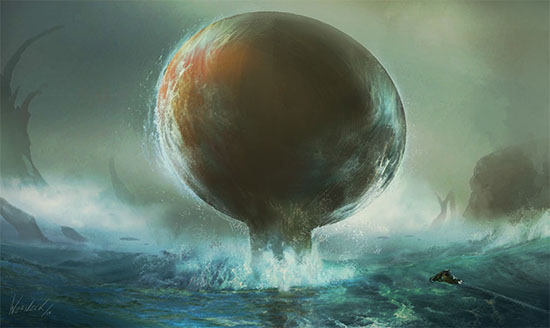Tagline: “The only rule we’re allowed to tell you is this one.” Great fun for the clever, the intrigued, and the sadistic.
 Imagine: You sit down at a table with your gaming buddies, and they’ve all got a funny grin on their face. “What is it?” you ask, oblivious to your inevitable fate this evening will bring to you. “We’ve got a new game,” they say. “Oh?” you say. “Sounds cool. What’s it called?” “Mao.”
Imagine: You sit down at a table with your gaming buddies, and they’ve all got a funny grin on their face. “What is it?” you ask, oblivious to your inevitable fate this evening will bring to you. “We’ve got a new game,” they say. “Oh?” you say. “Sounds cool. What’s it called?” “Mao.”
Maniacal laughter echoes through the room.
You’re confused. “Meow? Like the sound a cat makes?” “No, no,” they say. “Mao as in Mao Tse-tung. But that’s unimportant.”
Brave soul that you are, you say, “Well, what are the rules?”
More maniacal laughter.
“The only rule we’re allowed to tell you is this one.”
“Which one?”
“The only rule we’re allowed to tell you is this one.”
“You mean you can’t tell me any of the rules, except the rule which stops you from telling me the rules?”
“The only rule we’re allowed to tell you is this one.”
“Uhh… okay. Let’s go.”
WHAT IS MAO?
Mao, as you may have already surmised, is a card game where the first and foremost rule is that you cannot state the rules. You must learn while playing, all the while being penalized for breaking rules which you don’t even know exist. (Obviously you learn what you should be doing based on what you shouldn’t be doing and are getting penalized for, as well as the example of correct play from the other players.)
The other trick up Mao’s sleeve is that at the end of every round of play, the winner of that round gets to add a new rule to the game – a rule which he doesn’t tell to anyone else. The rule can take any form (including the overriding of the core rules) and remains in effect for the rest of the evening. Thus, even once you learn the game, you still haven’t learned the game.
The only other thing I can specifically tell you about this game is that it is played with two normal decks of 52 playing cards.
THEN HOW DO I LEARN?
There is, of course, at this point an obvious dilemma: How do you learn the game if I (and no one else) can tell you the rules and no one local to you knows how to play?
By reading an example of play.
With such an example no one is telling you the rules (and thus breaking the rules), but they do allow you to conclude what the rules are through inference.
The best resources I have found thus far are the pages of Ka Wai Tam. His examples of play are the best and most concise I have found, and he links to several other Mao resource pages.
MAO VARIATIONS
Things aren’t quite as easy as I’ve lead you to believe.
Anyone who is a card game aficionado (I occasionally like to think of myself as such) knows that the rules of games tend to fluctuate wildly over time. Although certain centralized resources such as Hoyle’s compendium have a tendency to lock certain games into specific patterns (Parker Brothers’ version of Monopoly, for example, has successfully wiped out the vibrant sub-culture of variant Monopolies which preceded it), the tendency is still there. Anyone with a roleplaying background shouldn’t find this all that surprising – the dawn of the industry were basically hacks of D&D which differed from it to various degrees, and today the web serves as a central clearinghouse of home rules, variants, and expansions for many popular systems.
A moment’s reflection should lead you to the quick realization that the basic nature of Mao would quickly lead itself to healthy perversions, growth, and variation. After all, the core spirit of the rules discourages setting anything down in stone – and someone who plays a brief session may never pick up on some of the subtle nuances (and thus would carry a distorted version of the game with them to be taught to someone else). Plus, the fact that you are supposed to add a new rule to Mao after every round of the game lends itself to the development of favorite home rules which may lead to their incorporation into the core rules.
The exact origins of Mao are unknown. There is a strong probability that it derived from a German card game called Mau-mau (note the similarity in name). Another path traces it to Bartog, a similar card game. All of these may ultimately be bizarre perversions of Nomic.
The earliest reference to Mao is to Mark Alexander’s group at Ithaca College in New York. Where it went from there is unclear, but apparently students carried it from one East Coast college to another. By the mid-‘80s there were hotbeds of Mao variant activity in Brooklyn, Pennsylvania, and Tennessee. Today there are at least three major “families” of Mao variants, and probably far more hanging around out there that we don’t know about.
(Check out Jason Holtzapple’s Unofficial Mao Card Game Site. He has a Mao Family Tree, documenting variants which are known to him. If anyone has knowledge of other variants, I’d loved to hear about them – and I’m sure Holtzapple would, too.)
Ka Wai Tam’s version of Mao is known as “Waterloo Mao” – it’s a fairly simple and straight-forward version, and is greatly helped by the fact that his examples of play are comprehensive to a degree which many other examples fail to achieve. (The only problem I had was figuring out some specific rules relating to spades. After some brief correspondence with him I believe I’ve got that sorted out, though – and will gladly help guide anyone to the proper conclusions. Then again, maybe I’ve intuited it all wrong and have introduced a whole new variant to Mao. Such is Mao.)
CONCLUSION
If you aren’t intrigued by Mao at this point, definitely skip it. It’s obviously not your type of thing. Personally, I stumbled across references to the game while doing some web research on Nomic (which I may eventually get around to reviewing as well) and was instantly ensnared by the concept. The game is both clever and complex, successfully existing at multiple levels of play, comprehension, and strategy. I heartily recommend it to card game fanatics everywhere.
Style: 5
Substance: 5
Author: Anonymous
Company/Publisher: None
Cost: Free!
Page Count: n/a
ISBN: n/a
Originally Posted: 2000/03/21
I remember this review creating a fascinating schism of reaction: A lot of people criticized me for posting a review of a free and public domain game. This seemed to be driven by a couple of factors: First, there were people who felt the primary purpose of a review was to tell them whether or not they should spend money on a game (and therefore a review of something free, which they could check out without paying anything, was pointless). Second, there were people convinced that Mao (or one of its variants) was so common that it was impossible that people hadn’t heard of it.
XKCD didn’t exist yet, so I wasn’t able to reference the lucky 10,000. But I felt personally vindicated in the review by those who replied to say that they hadn’t heard of the game but were intrigued by what I had to say.
For me, personally, Mao was both a revelation and a 60 day fad: I enjoyed it a lot. One of these days I should really teach it to myself again.
For an explanation of where these reviews came from and why you can no longer find them at RPGNet, click here.



 Hamlet offers an excellent example of why many modern editions of Shakespeare’s plays can’t be entirely trusted. While the traditions of emendation which have arisen around each play over the past 400 years have generally improved the texts, some of these traditions are both radically incorrect and yet rabidly stubborn in their persistence. It can be truly amazing to return to the original texts (imperfect as they may be) and discover that things you thought were fundamental to a play were, in fact, concocted out of whole cloth by an essentially random bloke in the 18th century.
Hamlet offers an excellent example of why many modern editions of Shakespeare’s plays can’t be entirely trusted. While the traditions of emendation which have arisen around each play over the past 400 years have generally improved the texts, some of these traditions are both radically incorrect and yet rabidly stubborn in their persistence. It can be truly amazing to return to the original texts (imperfect as they may be) and discover that things you thought were fundamental to a play were, in fact, concocted out of whole cloth by an essentially random bloke in the 18th century. Imagine: You sit down at a table with your gaming buddies, and they’ve all got a funny grin on their face. “What is it?” you ask, oblivious to your inevitable fate this evening will bring to you. “We’ve got a new game,” they say. “Oh?” you say. “Sounds cool. What’s it called?” “Mao.”
Imagine: You sit down at a table with your gaming buddies, and they’ve all got a funny grin on their face. “What is it?” you ask, oblivious to your inevitable fate this evening will bring to you. “We’ve got a new game,” they say. “Oh?” you say. “Sounds cool. What’s it called?” “Mao.”

 If heated, the seed produces no occluded gases. It contains no metals. Its substance cannot be identified with terrestrial tests, although it possesses a measurable magnetic field. Although non-volatile, it noticeably shrinks over time. (And even when physically isolated, the seed will continue shrinking while leaving behind no identifiable residue.)
If heated, the seed produces no occluded gases. It contains no metals. Its substance cannot be identified with terrestrial tests, although it possesses a measurable magnetic field. Although non-volatile, it noticeably shrinks over time. (And even when physically isolated, the seed will continue shrinking while leaving behind no identifiable residue.)









